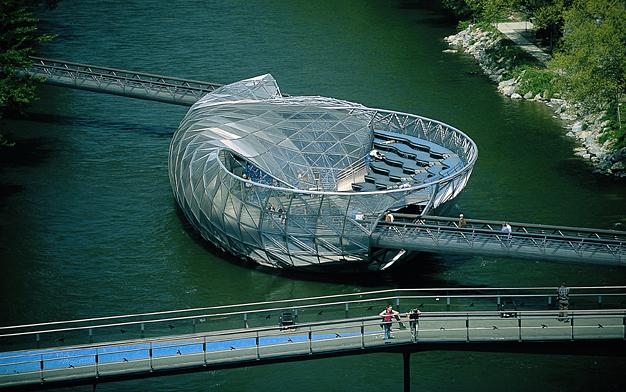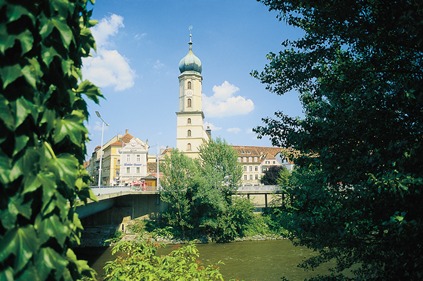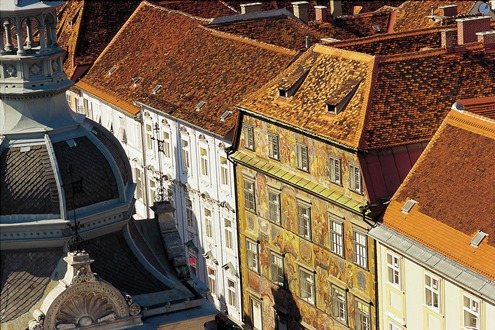Tourist Information
The Tourist Information is located in walking distance from the Summer School venue.
Address
Herrengasse 16, A-8010 Graz
Phone: +43-316-8075-0
E-mail: info@graztourismus.at
Website: www.graztourismus.at
Opening Hours
daily: 10.00 a.m. - 6.00 p.m.
Sightseeingwalk through Graz
The walk starts at the Rathaus (Town Hall) is located on the south edge of the Hauptplatz (main square) with its numerous market stalls. The place, on which merchants have been selling their goods for centuries, was chosen as a site for the Town Hall in 1550. Today's building originates from 1894 and replaces the smaller classicist town hall. Besides its distinctive cupola-scape, the town hall displays richly structured details on the façades. If you look at the left side of the city hall's entrance, you cannot overlook a Secco painting. This picture shows the history of the city hall in the various epochs. Above the entrance lies the municipal council hall, where the municipal council holds its meetings. The town hall is not only home to the mayor, the city government and the community representatives, it is a registry office as well – so on Saturdays you might come across illustrious wedding parties.
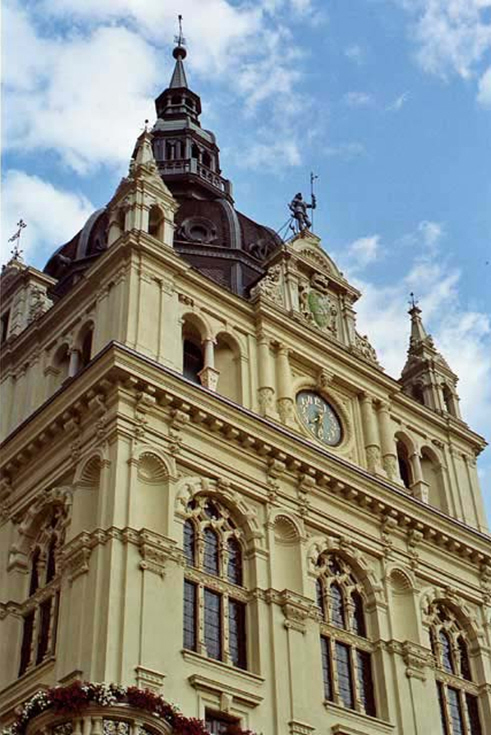 |
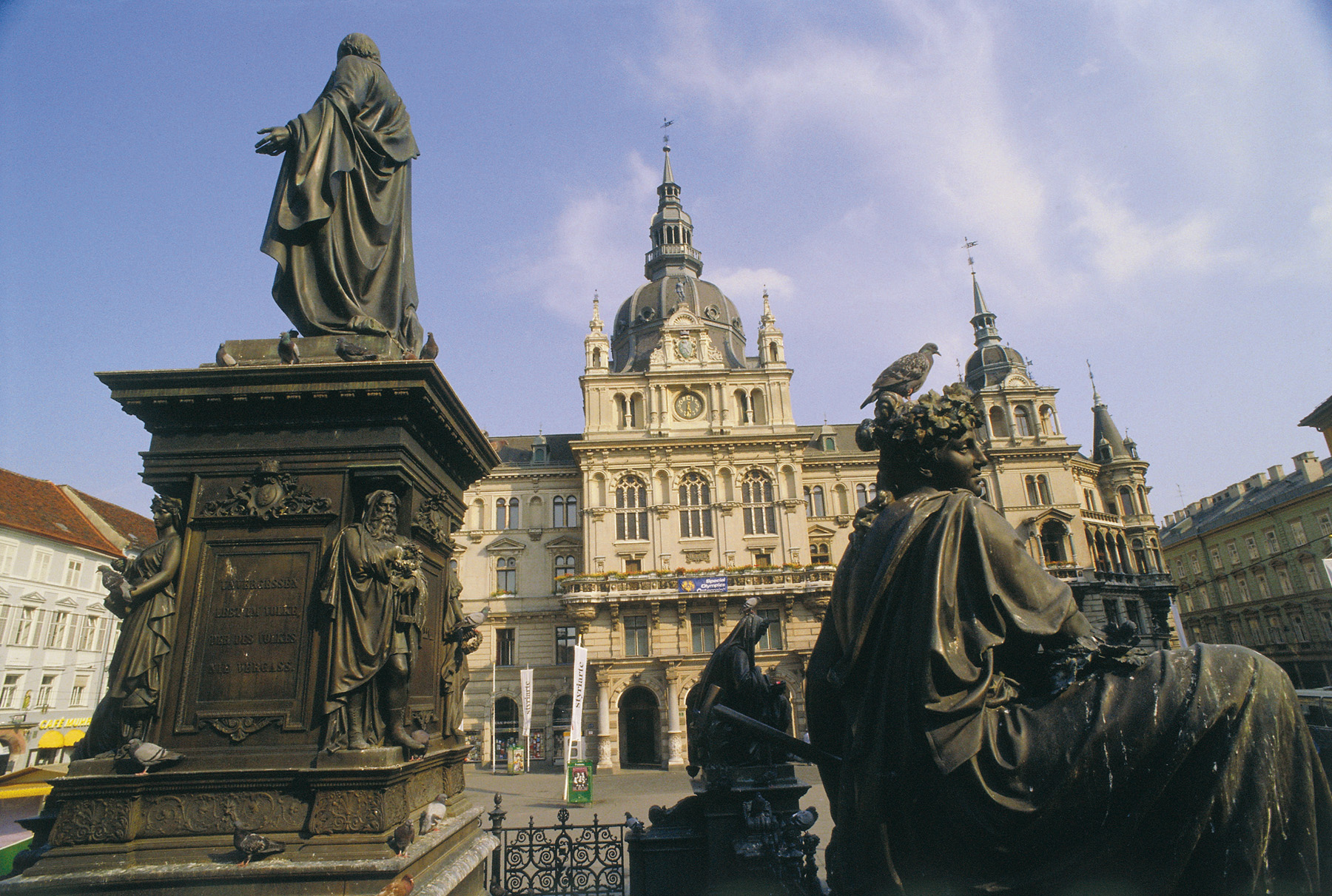 |
| The Rathaus (Town Hall) with the Erzherzog-Johann-Brunnen in front. | |
The centre of the square is dominated by the Erzherzog-Johann-Brunnen (Archduke Johann fountain), a monument created by Franz Xaver Pönninger, a pupil of Fernkorn in Vienna, established in 1878. It shows the "Styrian Prince", founder of the provincial museum Joanneum, which was to give rise to Graz University of Technology (established in 1855). The fountain is surrounded by allegories of the four main rivers in Styria at his time: the Mur, Enns, Drau and Sann rivers. The two male and the two female niche figures at the base of the monument represent the areas that Archduke Johann especially promoted: railway construction, science, mining and agriculture.
On the east side of the Hauptplatz, there are the splendid two Luegg houses (Hauptplatz 11 and 12), with their plentiful stucco front built around 1660-70. It is the earliest façade in Graz, which is covered with purely ornamental stucco. The stucco plasterers of the 17th century mainly came from Mesocco valley in Grisons, Switzerland – such as the stucco plasterer of the house at Hauptplatz 11, Antonio Teruggio.
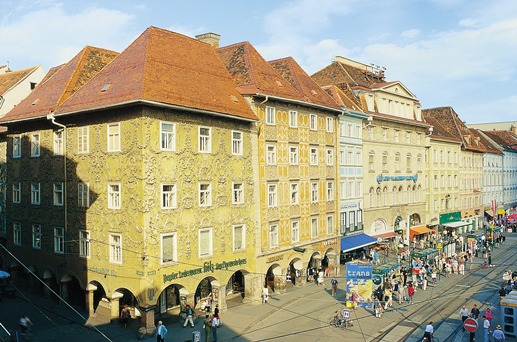 |
| The two Luegg houses (Hauptplatz 11 and 12), with stucco front built around 1660-70. |
Walking through the Murgasse and over the Hauptbrücke (main bridge) to the right riverbank you will reach the Kunsthaus (Art House). The location of the Kunsthaus had long been a matter of discussion (according to good old traditions, the municipality of Graz even carried out a public referendum) until the "friendly alien" found its final destination behind the façade of the Eisernes Haus (Iron House). The façade is listed as a historical monument. The Eisernes Haus is one of the earliest cast-iron constructions in Europe (1848).
With the Kunsthaus the British architects Peter Cook and Colin Fournier created a new landmark in Graz, thus creating a new area of architectural tension right in the heart of Graz. Like a huge bubble, the building, which is covered with acrylic glass, hovers over the bank of the river Mur and sucks in light through "nozzles" on the upper side.
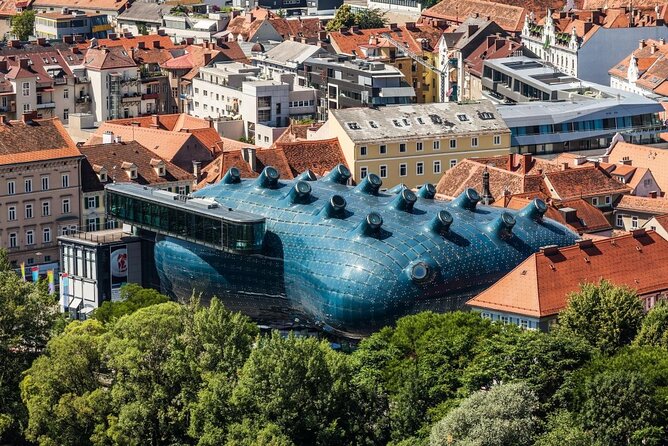 |
| The Kunsthaus (Art House) designed by the British architects Peter Cook and Colin Fournier represents a new landmark in Graz. |
From this location you have a nice view to the Schlossberg, which is a Dolomite rock that rises 123 m above the level of Hauptplatz. The Schlossberg came into the possession of the town in 1885. For easy access the Schlossberg funicular was built in 1894 and from 1914 to 1918 the path called Felsensteig was erected with the help of Russian prisoners of war. On the Schlossberg you see the landmark of the town of Graz, the Uhrturm (clock tower). The hands of the clock are reversed. Originally there was only one hand, the big one, which could be clearly seen even from a distance. It showed the hour, and the little hand was applied later. The clockwork mechanism as it is today has struck the hour since 1712. The tower was built from 1559-69 onwards using a fortified medieval tower that was already there. On the Uhrturm there are three bells: one is the oldest in Graz (cast in 1382), a fire bell (1645) and a bell called "Armesünderglocke" (around 1450). When this bell was rung it either indicated an execution or the closing of the city gates, and later, the closing time of inns and pubs.
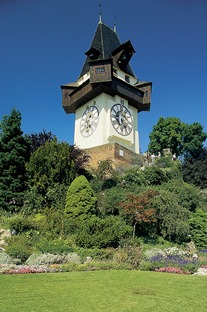 |
|
|||
| The Uhrturm (clock tower) on the Schlossberg, which is the landmark of Graz. | A new landmark in the water is the Murinsel (Island in the Mur) which was erected, according to the plans by New York architect and artist Vito Acconci, on the occasion of the appointment of Graz as the Cultural Capital of Europe 2003. |
When you look down to the river Mur you see the Murinsel (Island in the Mur), which was designed by New York architect and artist Vito Acconci: a new fruit growing out of the cultural axis. Go upstream a bit and follow the ramp onto the half open floating shell. The open part of the shell serves as an amphitheatre with room for up to 300 people to enjoy stage performances.
When you walk over the Hauptbrücke (main bridge) you will be in front of the Franziskanerkloster (Franciscan Monastry), which is the oldest existing settlement of an order on Graz town grounds. The monastery is the only one in Austria still continuing to accommodate brothers in the footsteps of Francis of Assisi. It was founded in 1239 by two Minorites (also called Friars Minor) and has been a Franziskanerkloster since 1515.
The Baroque bulb-shaped bell tower (finished in 1643), and the small shops dominate the exterior of the Franziskanerkirche (Franciscan Church), which is one of the parish churches of Graz today. Behind the church you see the cloisters, with its tombs dating to the 15th century, and a 14th century chapel where the now 10 resident monks pray. The striking angular position of the church is due to the flow of a former subsidary branch of the river Mur that once ran here.
|
|
| Franziskanerkirche (Franciscan Church), which is one of the parish churches of Graz today. |
After a few minutes walk you will arrive at the Landhaus, which is one of the most important Renaissance buildings in Styria. In 1494 the Styrian diet stopped holding "mobile" sessions and set up an office in a former town residence in Herrengasse. House after house was purchased so that between 1527-31 Italian architects were able to begin construction on the first Renaissance building of the city at the corner of Schmiedgasse/Landhausgasse. The wing of the Landhaus facing Herrengasse, with its early Renaissance arcade windows and the bell tower, is based on plans made by architect Domenico dell'Aglio starting in 1557. Dell'Aglio came from Scaria in Northern Italy. He was the person mainly responsible for the building of the fortresses in Inner Austria. On your way into the most impressive inner courtyard have a look at the "Runortafel", a special panel on the right of the entrance. According to a decree issued by Archduke Karl II in 1588, it was forbidden to move around, to wield daggers or bread knives, or to scuffle and fight; breaking this law resulted in severe punishment. In the last quarter of the 19th century, the building complex finally received the appearance it displays today. The Landhaus courtyard is one of Austria's most important Renaissance arcade courtyards.
Cast a glance at the columns that surround the courtyard and you will see the dragon gargoyles on the northwest and northeast sides (1561 and 1564).
The beautiful fountain with its depictions of mythological figures ranks among the most important bronze cast works in Mannerist style north of Italy (Mary Wening and Thomas Auer, 1589-90). The Styrian parliament still meets in the closed Baroque wing today.
The narrow building of the Landhaus is the Zeughaus (Provincial Armoury), which was built from 1644 onwards by Antonio Solar. The façade flaunts the portal with the Styrian provincial coat of arms and the coat of arms of the five members of parliament, flanked by the two niche figures of Mars, the god of war, and Minerva, the goddess of judicious war, wisdom, art and handicraft. The fire-expelling Styrian panther and the fireballs that form the crown of the portal testify to the great power of the building. Today the Zeughaus is one of the few armouries preserved in Europe and the only one that has stored its weapon collection here at this place over the centuries. It hosts 29.000 pieces, a small portion of the 185.700 pieces that were stored there in 1699.
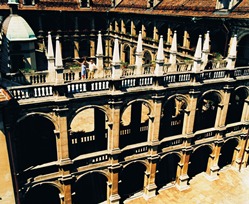 |
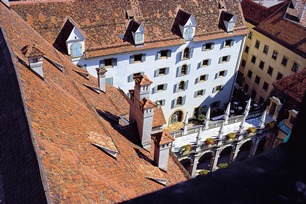 |
|
| The Landhaus courtyard is one of Austria's most important Renaissance arcade courtyards. The open gallery was built in 1889. | In 1644 Antonio Solar was commissioned to build the Provincial Armoury (seen in the back) on Herrengasse by the Styrian Estates. |
Landhaus and Zeughaus face the Herrengasse, which is the most prestigious street in the city centre of Graz. In the Middle Ages it was only a dead-end street between today's Landhausgasse and Jungferngasse, where the jewish ghetto began. Today the houses on your way through Herrengasse towards Hauptplatz have some stories to tell. The two monumental houses (one is number 28, the other spans numbers 22 to 26) were built by the busy theatre architects Helmer and Fellner (the architects of the opera house in Graz) in the 1880s. The patron was the Viennese company Thonet, which produced beech furniture. The composer Franz Schubert looks down from a commemorative plaque on the balcony of number 28 (close to the house with number 26). In September 1827, in the previously-existing building Schubert was once the guest of the pianist and advocate's wife, Marie Pachler. At that time her house was an important cultural centre in the city of Graz. In April 1797 Napoleon Bonaparte spent several nights at Herrengasse 13.
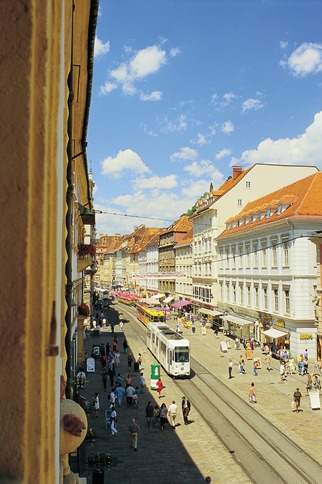 |
| The Herrengasse, which is the most prestigious street in the city centre of Graz. |
Towards Hauptplatz a building on the same side of the street, at Herrengasse 3, will immediately catch your eye the so-called Gemaltes Haus (Painted House). It has the only preserved fresco façade of this kind in Austria showing portrayals of the Gods and heroes of Greek and Roman mythology. The paintings, which were done 1742 by the Styrian artist Johann Mayer, were restored three times in the 20th century, as they were already extremely weather-beaten, but their meaning had fallen into oblivion. The figures were deciphered only a few years ago. The building is also called Herzogshof. Before the Habsburg dynasty established their own residence in Graz in the middle of the 15th century, they carried out their official buisness as sovereigns of Styria in the Herzogshof. The property manager's task was to set up the "sovereign's chair", and was thus released from paying taxes.
|
|
| On the facade of the so-called "Painted House" in Herrengasse, the cycle of paintings, dating from 1742, portrays the Gods and heroes of Greek and Roman mythology. The façade, which was painted by the Styrian artist Johann Mayer, is the only one of its kind which has been preserved in Austria. |
Through small passages you will reach the so-called Bermudadreieck (Bermuda Triangle) with its numerous pubs and restaurants on the squares of Glockenspielplatz, Mehlplatz and Färberplatz. The name Bermudadreieck comes from the fact that many have gone missing especially on mild summer evenings when the lure of the street-side wine taverns and beer gardens simply can't be resisted. Have a look at Mehlplatz 1, which is the former Palais Inzaghi, a little museum dedicated to Robert Stolz. The last composer of operettas was born in Graz in 1880 and grew up in this house. Many of his songs have become hits. He was a succesful film composer and got two "Oscars" for his work. The bourgeois town house at Mehlplatz 4, with its richly structured baroque façade, was erected at the beginning of the 18th century. Note that the organizer of the Summer School was living in an appartment at Mehlplatz 3 for several years during his undergraduate study at Graz University of Technology. At that time (30 years ago) cars were allowed to park in all the squares.
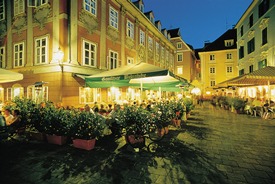 |
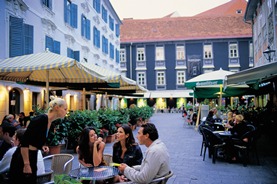 |
|
| On mild summer evenings Glockenspielplatz, Mehlplatz and Färberplatz - the so-called Bermudadreieck (Bermuda Triangle) - are one big guest garden. At Mehlplatz 1 (left house in the picture) there is the former Palais Inzaghi, a little museum dedicated to Robert Stolz. The last composer of operettas was born in Graz in 1880 and grew up in this house. |
The bourgeois town house at Mehlplatz 4 (i.e. the left house in the picture), with iths richly structured baroque façade, was erected at the beginning of the 18th century. |
Now you walk from Mehlplatz via Färbergasse, with the beautiful façades with Baroque ornamental structures, to the Sporgasse, which is one of the most romantic streets in Graz. Even though the houses mostly date back to the 16th century, Sporgasse is most remarkable for its façades that coexist alongside others from different stylistic eras. At the beginning of the street (just opposite the Luegg houses) you will find a floral art nouveau façade at number 3, unique for the city centre. The front of the building next to it dates back to the beginning of the 20th century. Here was the store of the furrier Mangold who produced and sold furs from otters, beavers and bears.
In Sporgasse it is also worth looking upwards. You will discover many interesting things such as the gargoyles on the roof at number 13, unique for a bourgeois house in Graz. The building is thought to have been redesigned by architect Joseph Hueber, who was very well-know in Graz between 1765 and 1770. For 350 years a brewery and an inn called "Zum Römischen Kaiser" were located in the building. Saint Nepomuk, the patron saint for water, is portrayed in a cartouche on the façade, and is supposed to guarantee the high quality of the most important raw material in the art of brewing.
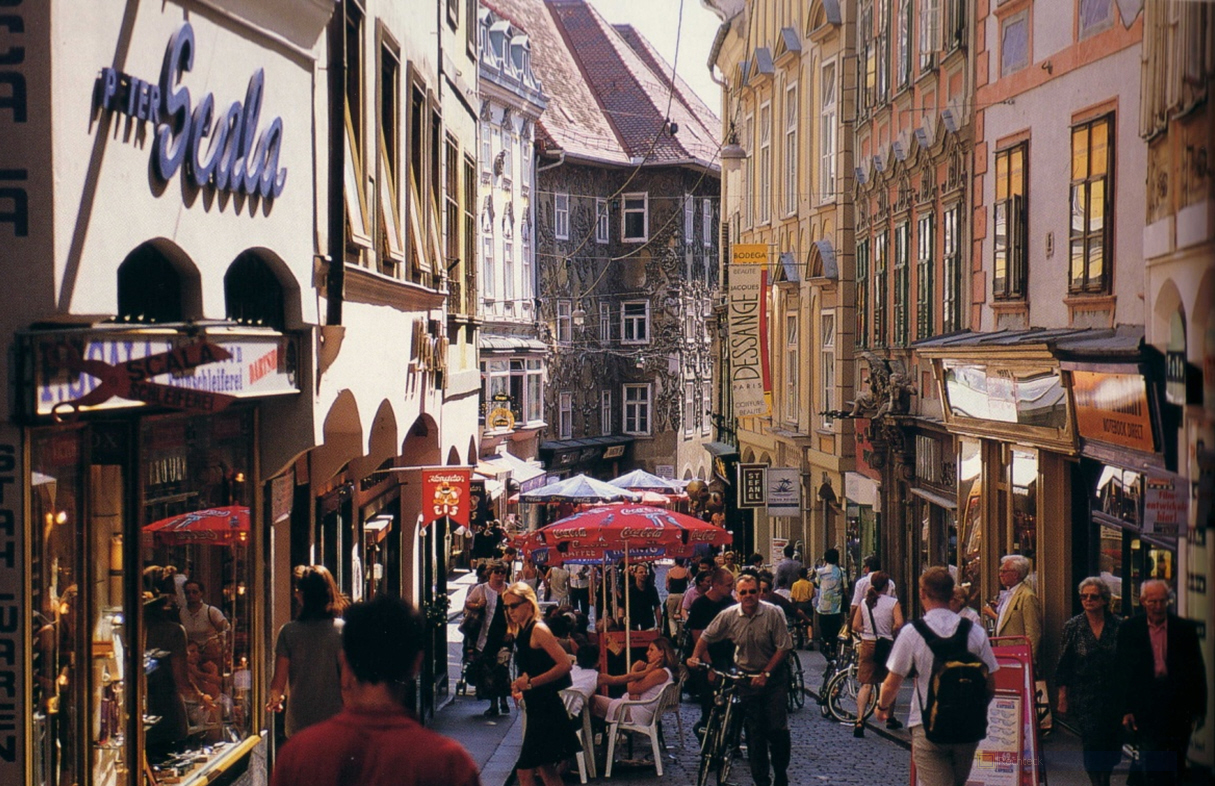 |
| The steeply ascending Sporgasse still follows the medieval course of the street. The lower part of Sporgasse has preserved its typical small bourgeois houses with their high-quality façades. |
At the corner house of Sporgasse/Hofgasse are three sandstone coats of arms made from 1691-92. These and the cross of the Teutonic order above the entrance commemorate the fact that the building was owned by the German order of Knights from 1680 to 1939.
From Sporgasse you now turn into Hofgasse where three buildings immediately catch your eye: (i) a shop, designed by the London architect Claudio Silvestrin in the form of a temple; (ii) in contrast, the Hofbäckerei (court bakery) Edegger-Tax with its portal consisting of oak and walnut inlays made in the year 1896 by Anton Irschick, a master court carpenter, and (iii) the house number 10, the also called "Taubenkogel" because of its strange tower with a staircase looking onto the courtyard. This tower was attached to the Jesuit grammar school building when it was adapted in the year 1619. The unique way the façades in Graz were modelled on those of the high Ranaissance Rome is of cultural and historical interest.
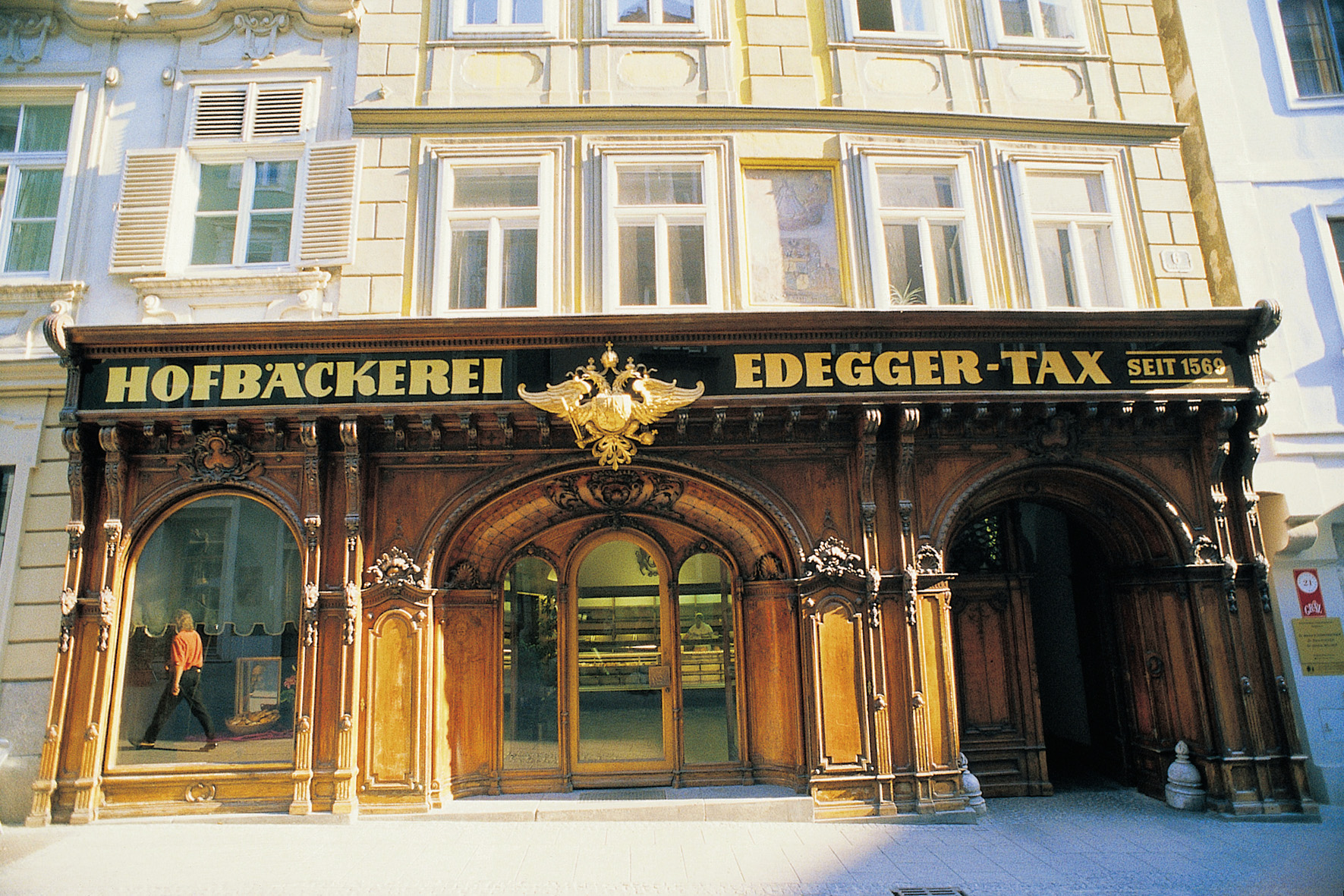 |
| In 1896 the imperial and royal ("k.k") cabinet maker Anton Irschick crafted the lavish wooden panelling of the Hofbäckerei Edegger-Tax. |
Walking along Hofgasse you come to Freiheitsplatz, a square that was built in the years 1835-40 after the estate theatre, today the Schauspielhaus, had burned down. The old theatre was built in 1776; the outer appearance of the Schauspielhaus, as it is today, largely corresponds with the new neo-classic building designed by Peter Nobiles.
In former times the name of the Freiheitsplatz was Franzensplatz because of the monument to Emperor Kaiser Franz I of Austria. The bronze statue of Franz I, which was cast in Milan by the sculptor Pompeo Marchesi, accentuates the centre of the square. In November 1918 the republic was proclaimed from the balcony of the Schaupielhaus, and that's how the place got its present name. With its closed house fronts built in the late Classic and Biedermeier periods, and the façades decorated with columns on the north front, this square was commonly said to be, in the middle of the 19th century, the most beautiful in Graz.
Just opposite the Schauspielhaus you see the Alte Universität (old University). It was in 1585 that Archduke Karl approved the expansion of the Jesuit Collegium into a University. Between 1607 and 1609 under Archduke Ferdinand II, a separate university buiding was built next to the Jesuit Collegium. On the façade two coats of arms made of stone will catch your eye. They commemorate Archduke Ferdinand II and his wife Maria Anna of Bavaria. Only the coat of arms and the stone portal bearing the epigraphs "Universitas", "IHS" (symbol of the Jesuits, and commonly used for Jesus) and "MRA" (meaning Maria) stem from the original façade. The lecture halls were situated on the ground level, and above them were a great hall and an academic theatre. Although the Jesuit University only consisted of a philosophical and theological faculty, the mathematical-scientific subjects also were of high standing.
Now turn to the Domkirche. It began its turbulent history as a Romanesque parish church dedicated to St. Ägydius, first mentioned in 1174. From 1438 onwards the later Emperor Friedrich III had a late Gothic courtyard and a parish church built here, which was connected to his new residence castle until the middle of the 19th century. Friedrich III was crowned German King in 1440 and Roman Emperor in 1452. His hometown Graz remained his most favourite residence. As a church of the Jesuit order it had been the centre of the Counter-Reformation from 1573 onwards. After dissolution of the Jesuit order and the bishop's seat in Seckau in upper Styria it became a bishop's church of Styria in 1786.
Today its architectural features still correspond to a late Gothic church, with its wide, hall-like nave, narrow choir and lack of towers (the ridge turret was added only later) that Friedrich III ordered to be built. Also the external form of the building is simple, with only the main portal in the west being richly structured. On top of the portal, Friedrich immortalised himself as Emporer with his motto AEIOU (explained below) and shields showing the double-headed Imperial Eagle and the Austrian emblem as well as the coats of arms of Portugal and Styria. He had the coat of arms of Portugal put up in honour of his wife Elenore, the daughter of the Portuguese king.
The only original painting on the outside of the church is the partly-preserved Gottesplagenbild (Plagues of God Picture) painted by Thomas von Villach in 1485 on the south side of the Dome. It refers to the terrible year of 1480 when Styria was hit by three biblical plagues: hunger (plague of locusts), war (first entering of the Turks in the area of Graz) and death (plague epidemic). God's three plagues are depicted in the lowest part of the picture. In the middle part of the three fields (Turks) one can find the oldest portrayal of Graz as well.
Just beside the Domkirche is a building that is one of the most important constructions from the first half of the 17th century in Austria, the Mausoleum of Emperor Ferdinand II. The mausoleum was designed by Giovanni Pietro de Pomis by order of Ferdinand II starting in 1614. The interior decoration is from 1687 and based on the design of Johann Bernhard Fischer von Erlach.
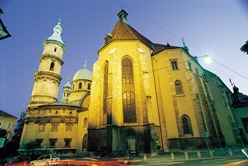 |
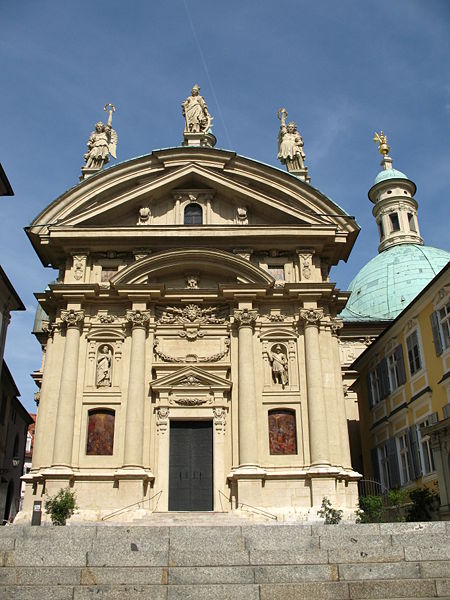 |
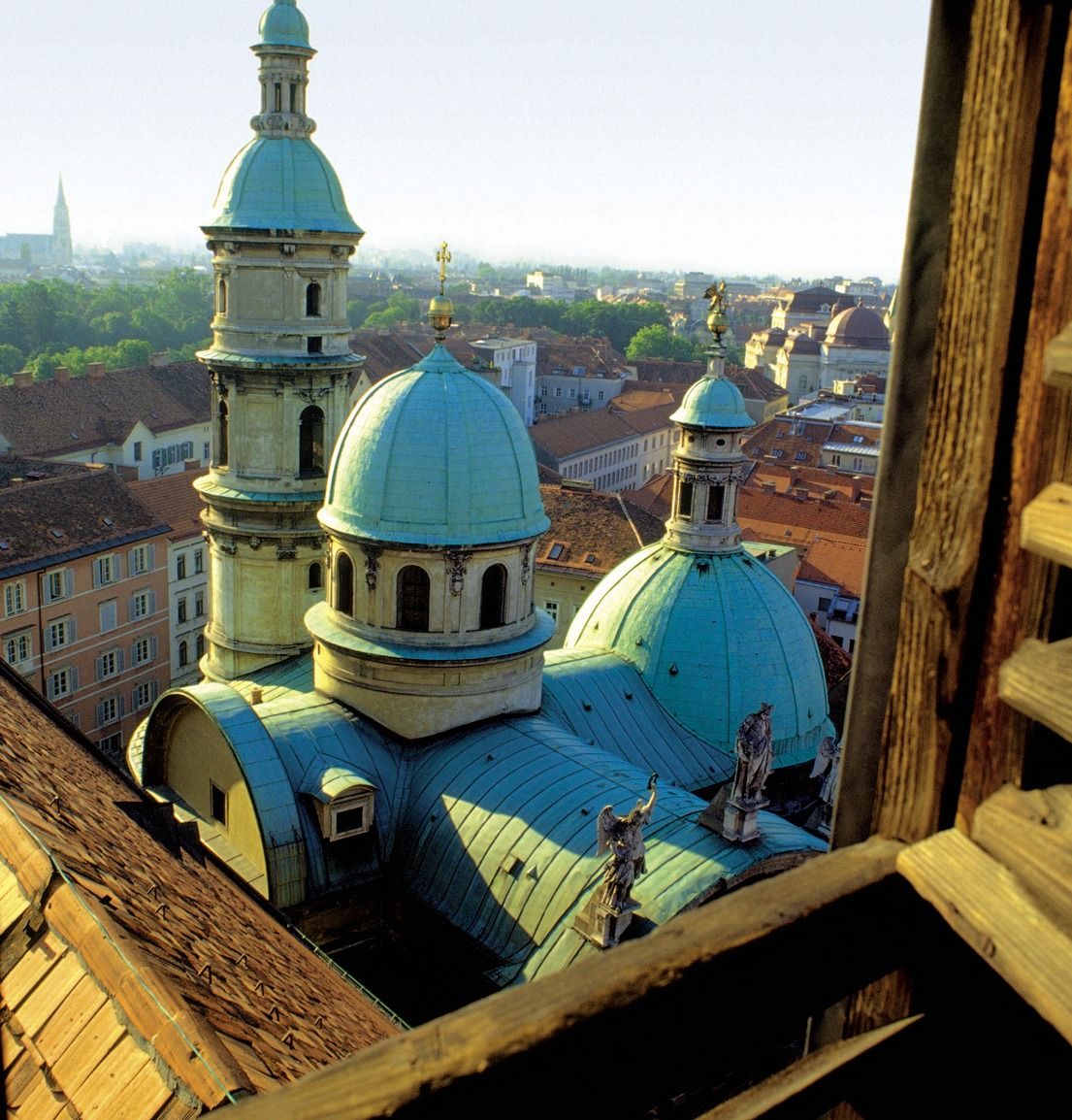 |
|
| The late Gothic choir of the parish church St. Ägydius, which was built in 1438 and elevated to the rank of a cathedral church of the Diocese Graz-Seckau in 1786. |
The mausoleum of Emperor Ferdinand II, which was erected by Giovanni Pietro de Pomis starting in 1614, is one of the most important buildings in Austria from the first half of the 17th century. |
||
Just across from the Domkirche is the Burg (castle). In the tower left of the drivethrough, after the first courtyard, you see the Gothic Doppelwendeltreppe (double-spiral staircase) of 1499, which is a masterpiece of the art of stonemasonary at the end of the Gothic epoch. The son of Emperor Friedrich III, namely Maximilian, was responsible for the castle's double spiral staircase. It is a twin spiral staircase, whose both flights of steps, each from an independent spiral staircase, unite on each floor into a common landing. Up to until the second floor, the staircase is draped around a newel, but then continues as a widely suspended stone construction. When the sun shines through the windows the sandstone shines in many colours.
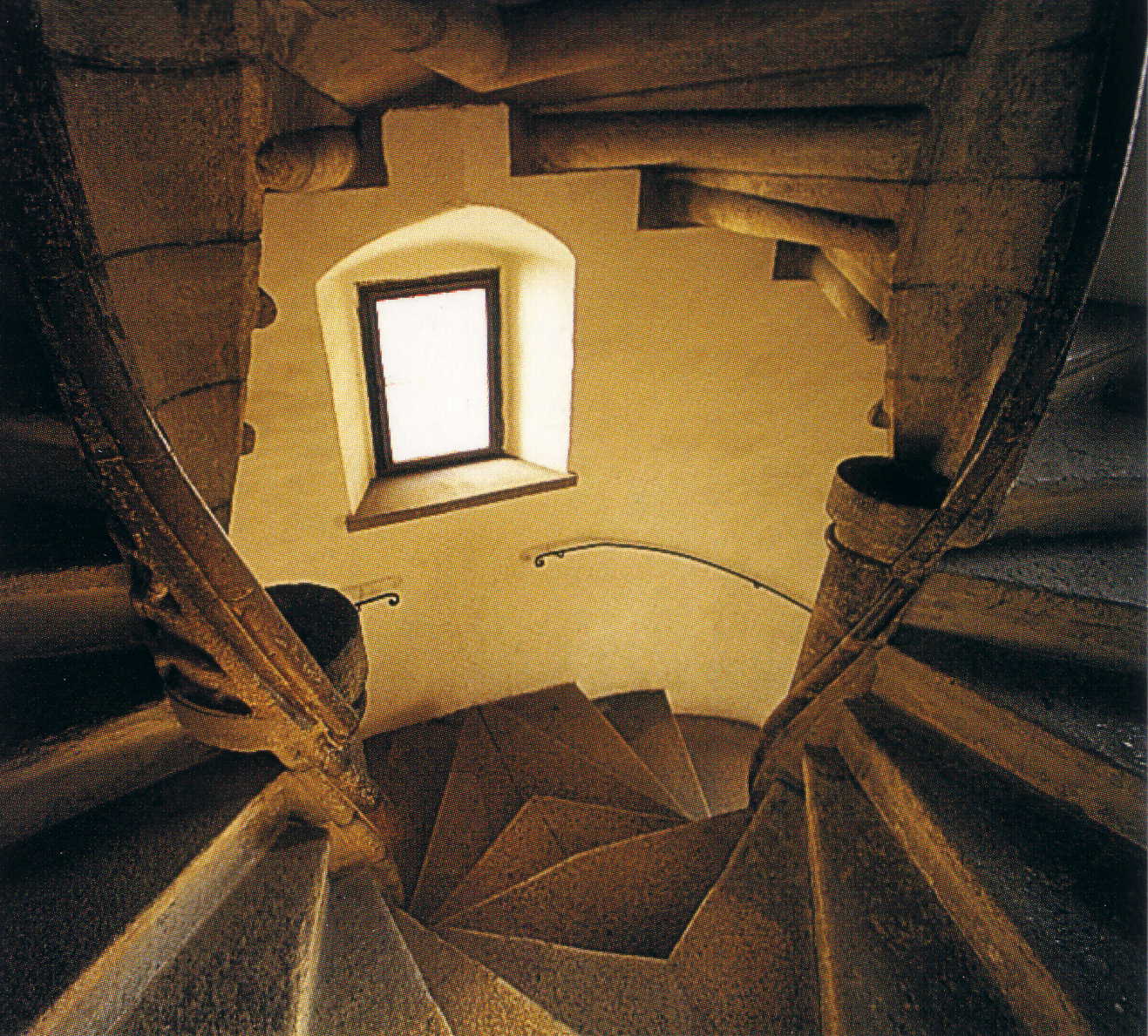 |
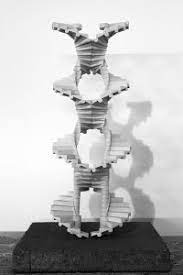 |
|
| One of the most important late Gothic staircase complexes - the castle's double spiral staircase, built in 1499 under Emporer Maximilian. |
Model of the double spiral staircase. |
Archduke Friedrich III began building the residence of the Habsburg court from 1438, and it was later expanded by his successors. The Burg from Friedrich's time consisted of two wings. In the middle of the 19th century the accommodation wing on the Hofgasse side and the passageway to Hofkirche were torn down because they were presumed to be in a state of dilapidation. By entering the first courtyard of the Burg through the mighty Renaissance gate you will detect interesting medieval traces. On top of the next gate you see, for example, the letters AEIOU and the year 1453. Above the inscription is a monogrammed stone bearing Friedrich's name and his motto, which is entwined with the monogram of Christ. With these letters Emperor Friedrich III declared the purpose of this motto that he used from 1437, namely:
"On whichever building, silverware or jewellery the five letters stand, it is mine or I allowed it to be built or done".
Later, more than 300 interpretations for the five letters AEIOU were found. The best known and most used stands for "Austriae Est Imparare Orbi Universo" (all earth is subject to Austria). Since Friedrich III was only the archduke of Styria at the time of the diary entry and since he couldn't hope to become king, AEIOU might not have had any political meaning.
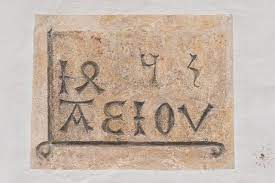 |
| AEIOU, Friedrich's secret motto, first occurring in his diary of 1437: on whichever building, silverware or jewellery the five letters stand, it is mine or I allowed it to be built or made. |
The Burg together with the Gothic cathedral, the theatre (Schauspielhaus) and the old Jesuit University from the so-called Stadtkrone (city crown of Graz).
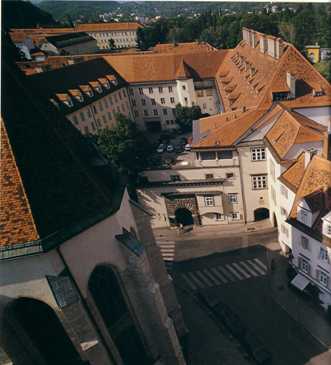 |
| The former imperial and princely castle has been the official residence of the Provincial Governor of Styria since 1922. |
Since 1922, the Burg has been used as the official residence of the Provincial Governor of Styria.


